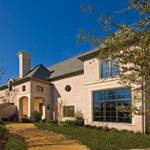At a Glance
Company headquarters
Atlanta
Construction department employees
16
Average project duration
9 months
Current locations
2,250
Because Home Depot USA Inc. locations are generously sized, with typical square footages of more than 100,000 square feet, one might imagine that challenges related to heating, cooling, and overall energy efficiency often come into play. Not so for the brand’s new location in Lodi, California, which, though a full 106,000 square feet with a roof just as large, includes design elements that reduce energy demand inside while cutting heat gain from both the roof and the parking lot—even on the hottest Central Valley days.
The store, which opened in 2012, is meant to serve as a model for all future Home Depot construction. And, the brand’s rigorous testing of the location’s energy- and water-conservation capabilities has revealed something important: the retail chain, which helps its millions of customers make eco-friendly improvements to their homes and businesses, is more than capable of making similar significant improvements to its own stores, both new and existing.
According to the chain’s corporate director of construction, David Oshinski, Home Depot has been rolling out green efforts sporadically in its 2,250 stores in the United States, Canada, Mexico, and China since as early as 2003. The analysis of the Lodi location, though, provides some of the first concrete, convincing data that these efforts are causing energy use within the brand’s stores to plummet.
Perhaps the most visible green measure the big-box retailer has employed at certain locations is a massive catchment system. In Florida and the Virgin Islands—where, as in Lodi, there are rainy-dry seasonal cycles—stores are now capturing storm water on their rooftops and funneling it into 500,000-gallon tanks that sit nearby. Enough is continually gathered to irrigate 40–60 percent of the stores’ sizeable garden centers.
The rooftop improvements don’t stop there. Other stores are phasing in white membrane coverings—which naturally reduce solar-heat absorption—to replace black ones. And new locations’ roofs will slope upward from front to back, lowering ceiling heights by four feet at the cashier end and limiting the amount of internal space that needs to be cooled and heated.

Overall, the retailer follows a sustainability-integration system that encompasses operations (energy and water use), merchandising (product selection), supply-chain management (fleet-mileage reduction), information technology (server demands), and mitigation of climate-change risk (better drought tolerance and construction methods). Notably, it has invested more than $250 million to create regional distribution centers that reduce overall delivery miles driven by vendors. This helped reduce enterprise-wide carbon dioxide emissions from seven million metric tons in 2009 to 5.6 million metric tons in 2011. Other savings are realized through lighting modernization, including replacing incandescent bulbs with compact fluorescents and LEDs and adding motion sensors that keep the lights turned off when aisles are empty.
Home Depot shares its sustainable practices with other big-box retailers through the Commercial Building Energy Alliance. Members represent more than eight billion square feet of building space, which is about 20 percent of all commercial space in the country. Member companies, including Costco, Lowe’s, Macy’s, McDonald’s, Starbucks, and Target, share tools and technologies that help each reduce its energy use.
The Lodi store experiment drills deep into how energy is used and saved, and Home Depot’s internal environmental sustainability committee is monitoring the site intensely, but there’s always more that can be accomplished. “LED lights are going to amaze us in three years,” Oshinski says, adding that Home Depot stores will continue to adopt such product innovations and new practices early and often. ABQ
______________________

Meet David Oshinski
Where did you go to school?
I earned an undergraduate business degree at Ferris State University [in Big Rapids, Michigan] and worked on a master of management degree at Aquinas College [in Grand Rapids, Michigan].
What was your first construction job?
I come from a long line of construction people, going back to my great grandfather, a construction-project manager, and my great uncles, who were masons who built churches and schools in Grand Rapids. Even my father, an auto executive in Michigan, built dozens of houses on the side. I visited my first jobsite at the age of two.
How did you wind up working for Home Depot?
I was hired as a construction manager by Wal-Mart Stores, Inc. in 1994. By the time I left the company in 2006, I was overseeing a $700 million budget as director of construction. Since that year, I have served as corporate director of construction at Home Depot.
What personal goals do you have in your current role?
I participate in a slew of professional organizations related to construction and retailing, including the Commercial Building Energy Alliance steering committee, the editorial board of Retail Construction Magazine, and the Sustainable Retail Consortium of the National Retail Federation. This business is changing so fast; it’s exciting to see what will happen in just the next few years.


